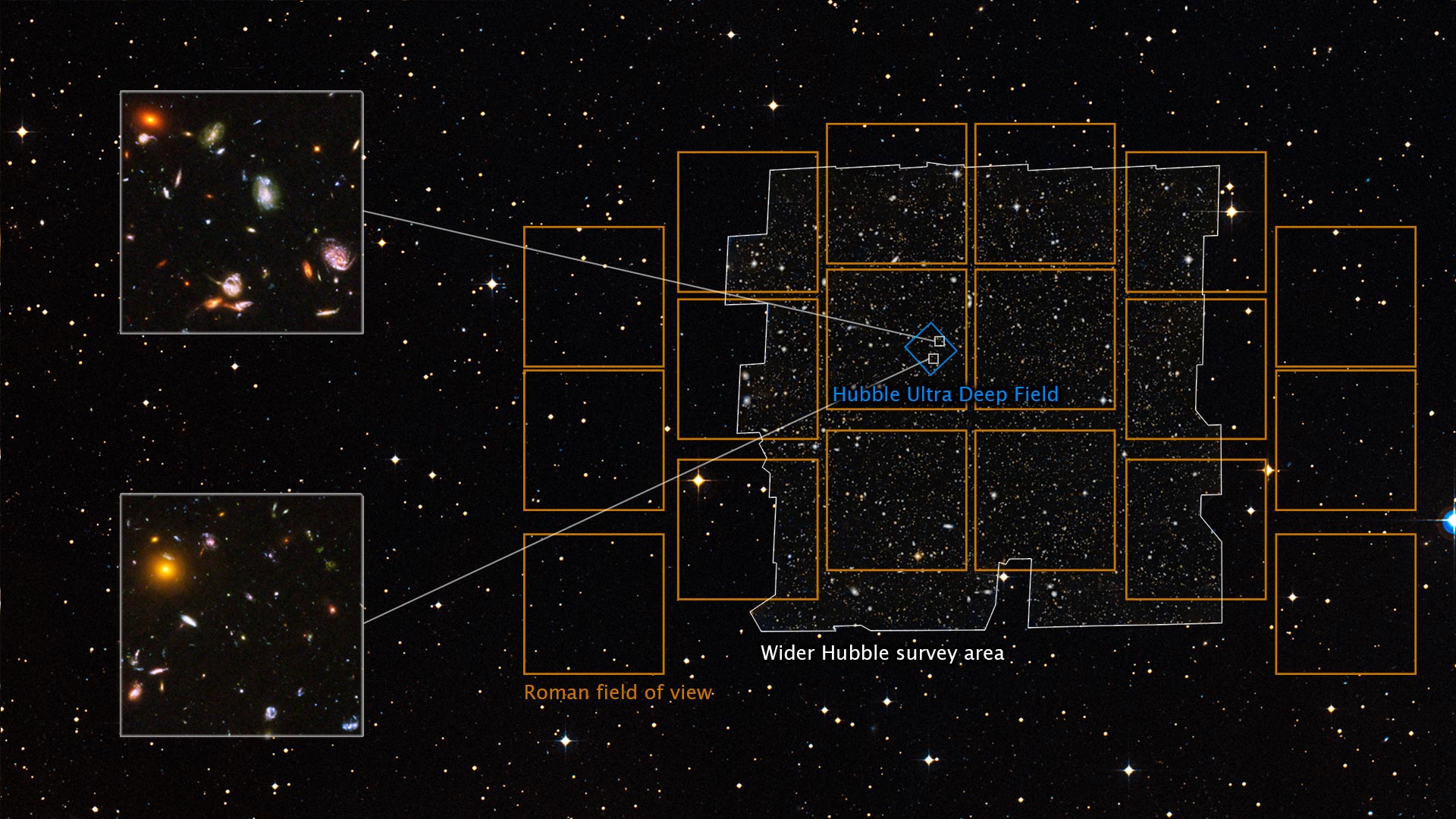
In a deep field, astronomers collect light from a patch of sky for an extended period of time to reveal the faintest and most distant objects.
This view centers on the Hubble Ultra Deep Field (outlined in blue), which represents the deepest portrait of the universe ever achieved by humankind, at visible, ultraviolet and near-infrared wavelengths.
Beyond the Hubble Ultra Deep Field, additional observations obtained over the past two decades have filled in the surrounding space.
These wider Hubble observations reveal over 265,000 galaxies, but are much shallower than the Hubble Ultra Deep field in terms of the most distant galaxies observed.
An orange outline shows the field of view of NASA’s upcoming Nancy Grace Roman Space Telescope.
Roman’s 18 detectors will be able to observe an area of sky at least 100 times larger than the Hubble Ultra Deep Field at one time, with the same crisp sharpness as Hubble.
The resulting Deep Field image captured thousands of previously unseen, distant galaxies.
Similar observations have followed since then, including the longest and deepest exposure, the Hubble Ultra Deep Field.
Now, astronomers are looking ahead to the future, and the possibilities enabled by NASA’s upcoming Nancy Grace Roman Space Telescope.
The Roman Space Telescope will be able to photograph an area of sky 100 times larger than Hubble with the same exquisite sharpness.As a result, a Roman Ultra Deep Field would collect millions of galaxies, including hundreds that date back to just a few hundred million years after the big bang.
This zoom-out animation begins with a view of the Hubble Ultra Deep Field (outlined in blue), which represents the deepest portrait of the universe ever achieved by humankind, at visible, ultraviolet and near-infrared wavelengths.
An orange outline shows the field of view of NASA’s upcoming Nancy Grace Roman Space Telescope.Roman’s 18 detectors will be able to observe an area of sky at least 100 times larger than the Hubble Ultra Deep Field at one time, with the same crisp sharpness as Hubble.
One of the Hubble Space Telescope’s most iconic images is the Hubble Ultra Deep Field, which unveiled myriad galaxies across the universe, stretching back to within a few hundred million years of the Big Bang.NASA’s upcoming Nancy Grace Roman Space Telescope will be able to photograph an area of the sky at least 100 times larger than Hubble with the same crisp sharpness.Among the many observations that will be enabled by this wide view of the cosmos, astronomers are considering the possibility and scientific potential of a Roman Space Telescope “ultra-deep field.” Such an observation could reveal new insights into subjects ranging from star formation during the universe’s youth to the way galaxies cluster together in space.
A Roman ultra deep field could greatly benefit the scientific community, say astronomers.
As an example, a Roman ultra-deep field could be similar to the Hubble Ultra Deep Field – looking in a single direction for a few hundred hours to build up an extremely detailed image of very faint, distant objects.Those galaxies are also the rarest: for example, only a handful are seen in the Hubble Ultra Deep Field.
Malhotra is a co-investigator on the Roman science investigation teams working on cosmic dawn, and has led programs that do deep spectroscopy with Hubble, to learn about distant, young galaxies.
A Roman ultra-deep field would contain information on millions of galaxies – far too many to be studied by researchers one at a time.